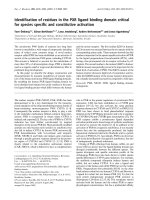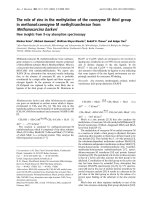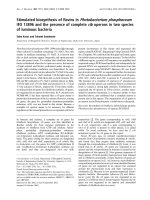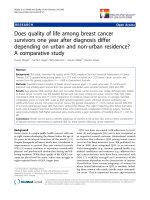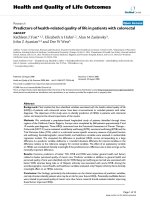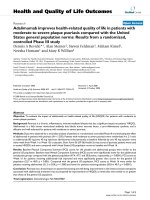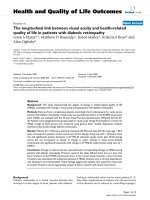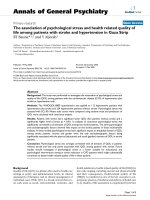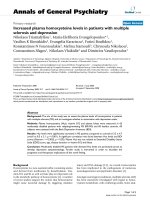Báo cáo y học: " Health-related quality of life in patients with pulmonary arterial hypertension" pptx
Bạn đang xem bản rút gọn của tài liệu. Xem và tải ngay bản đầy đủ của tài liệu tại đây (437.74 KB, 10 trang )
BioMed Central
Page 1 of 10
(page number not for citation purposes)
Respiratory Research
Open Access
Research
Health-related quality of life in patients with pulmonary arterial
hypertension
Darren B Taichman*, Jennifer Shin, Laryssa Hud, Christine Archer-Chicko,
Sandra Kaplan, Jeffery S Sager, Robert Gallop, Jason Christie, John Hansen-
Flaschen and Harold Palevsky
Address: Pulmonary, Allergy and Critical Care Division, University of Pennsylvania School of Medicine, University of Pennsylvania Medical
Center-Presbyterian, Philadelphia, PA 19104, USA
Email: Darren B Taichman* - ; Jennifer Shin - ;
Laryssa Hud - ; Christine Archer-Chicko - ;
Sandra Kaplan - ; Jeffery S Sager - ; Robert Gallop - ;
Jason Christie - ; John Hansen-Flaschen - ;
Harold Palevsky -
* Corresponding author
Abstract
Background: Improved outcomes with expanding treatment options for patients with pulmonary
arterial hypertension present the opportunity to consider additional end-points in approaching
therapy, including factors that influence health-related quality of life. However, comparatively little
is known about health-related quality of life and its determinants in patients with pulmonary arterial
hypertension.
Methods: Health-related quality of life was evaluated in a cross sectional study of 155 outpatients
with pulmonary arterial hypertension using generic and respiratory-disease specific measurement
tools. Most patients had either World Health Organization functional Class II or III symptoms.
Demographic, hemodynamic and treatment variables were assessed for association with health-
related quality of life scores.
Results: Patients with pulmonary arterial hypertension suffered severe impairments in both
physical and emotional domains of health-related quality of life. Patients with idiopathic ("primary")
pulmonary arterial hypertension had the best, and those with systemic sclerosis the worst health-
related quality of life. Greater six-minute walk distance correlated with better health-related quality
of life scores, as did functional Class II versus Class III symptoms. Hemodynamic measurements,
however, did not correlate with health-related quality of life scores. No differences in health-
related quality of life were found between patients who were being treated with calcium channel
antagonists, bosentan or continuously infused epoprostenol at the time of quality of life assessment.
Conclusion: Health-related quality of life is severely impaired in patients with pulmonary arterial
hypertension and is associated with measures of functional status. Specific associations with
impaired health-related quality of life suggest potential areas for targeted intervention.
Published: 10 August 2005
Respiratory Research 2005, 6:92 doi:10.1186/1465-9921-6-92
Received: 21 June 2005
Accepted: 10 August 2005
This article is available from: />© 2005 Taichman et al; licensee BioMed Central Ltd.
This is an Open Access article distributed under the terms of the Creative Commons Attribution License ( />),
which permits unrestricted use, distribution, and reproduction in any medium, provided the original work is properly cited.
Respiratory Research 2005, 6:92 />Page 2 of 10
(page number not for citation purposes)
Introduction
Pulmonary arterial hypertension (PAH) is a devastating
disease, characterized by progressive dyspnea and exercise
limitation. If not effectively controlled, PAH often
progresses to right heart failure and premature death [1-
3]. Fortunately, recent dramatic advances in pharmaco-
logical treatment have brought about significant improve-
ments in physical functioning and survival, and new
therapeutic options are emerging at a rapid pace [4].
Improved outcomes with expanding treatment options
present the opportunity to consider additional end-points
in choosing approaches to therapy, including factors
influencing health-related quality of life.
Presently, little is known about the determinants of
health-related quality of life (HRQOL) in patients with
PAH. An improved understanding of these determinants
will be essential as HRQOL becomes an important out-
come in research on therapeutics for PAH [5,6].We stud-
ied health-related quality of life in a large population of
PAH patients and performed an initial assessment of the
clinical factors associated with better (or worse) HRQOL.
Methods
Study Design and Patients
We conducted a cross sectional survey of HRQOL in
patients cared for in the Pulmonary Vascular Disease Pro-
gram at the University of Pennsylvania Health System.
Previously established as well as newly referred patients
with PAH were asked to complete HRQOL questionnaires
over one year (October, 2002 – September, 2003). PAH
was defined according to standard criteria, including a
mean pulmonary artery pressure >25 mmHg at rest or 30
mmHg with exertion, and the absence of significant left
heart dysfunction [7,8]. Patients completed question-
naires without assistance at regularly scheduled appoint-
ments prior to the physician evaluation. Physicians and
nurses were not aware of HRQOL survey responses.
Patient demographics, symptoms, medications, and phys-
ical exam findings on the day of HRQOL evaluations were
obtained by chart review, as were demographic values.
Test results within three months of HRQOL assessment
were recorded (e.g. hemodynamic values from cardiac
catheterization in 103 patients and six-minute walk dis-
tance in 33 patients).
Health-Related Quality of Life Measurements
We administered a generic and a respiratory disease-spe-
cific quality of life questionnaire. The Medical Outcome
Study 36 Item Short Form health survey (SF-36, standard
form, version 2; Quality Metric, Lincoln, RI) yields scaled
scores in 8 physical and mental health areas affected by
health and disease conditions, in addition to physical
component and mental component summary scores [9].
The St. George's Respiratory Questionnaire (SGRQ) is a
well validated respiratory disease specific HRQOL meas-
ure, yielding scores related to symptoms (concerning the
frequency and severity of respiratory symptoms), activity
(the degree to which activities are limited by breathless-
ness), and impact (aspects of social and psychological
function affected by respiratory disease). In addition, a
total score summarizes disease impact on overall health
status [10].
Statistical Analysis
Scores for the 8 domains and 2 summary measures of the
SF-36, and the 4 scores of the SGRQ were calculated elec-
tronically according to published guidelines, including
imputation for missing responses [9]. Higher SF-36 scores
indicate better quality of life, whereas higher SGRQ scores
indicate poorer HRQOL. SF-36 scores are normalized to a
mean of 50 and standard deviation of 10, based on the
normal US population. Mean raw scores on the SGRQ
were compared with established normal population
scores [11].
Data were entered into a Microsoft Access 5.1 database
(Microsoft Corporation) and statistical analysis per-
formed with SAS 8.2 software (SAS Institute, Cary, NC).
Data were analyzed for differences using an independent
t-test for binary predictors, ANOVA for categorical predic-
tors, and correlation coefficients for continuous measures.
Comparisons between patient groups were limited to the
physical and mental component summary scores of the
SF-36, and significant associations defined as those hav-
ing a p ≤ 0.05.
Normalized physical and mental component summary
scores were calculated from published studies of popula-
tions with various chronic diseases using reported individ-
ual SF-36 domain scores and an on-line scoring program
/>.
This study was approved by the Institutional Review
Board of the University of Pennsylvania.
Results
Patient Characteristics
Health-related quality of life was examined in 155 adult
outpatients. The population was 81% female with an
average age of 53 years, ranging from 18 to 84. Other
physical and social characteristics of the study population
are shown in Table 1. Thirty-three patients (21% of the
sample) completed HRQOL questionnaires at the time of
initial evaluation in a pulmonary vascular disease spe-
cialty program. Patients who had been followed for treat-
ment of PAH for up to 1, 2 or 3 years accounted for 19, 25
and 14 percent of evaluations, respectively; the remaining
21% of patients had been followed longer than 3 years.
Respiratory Research 2005, 6:92 />Page 3 of 10
(page number not for citation purposes)
Approximately one third of patients had idiopathic ("pri-
mary") pulmonary arterial hypertension and most had
either World Health Organization Class II or III symp-
toms. The majority were married and only 14 percent
lived alone. Thirty-five percent of the patients were
employed.
Health-Related Quality of Life Scores
Patients with PAH had significantly depressed physical
and mental health-related quality of life (Figure 1). On
the SF-36, a "generic" measure of HRQOL applicable to a
wide range of populations and disease states, HRQOL was
impaired in every domain, representing a broad range of
quality of life concepts (p < 0.001 for each). Mean scores
were particularly depressed for the general health, physi-
cal functioning, role physical and emotional domains. In
addition, the physical component summary (PCS) and
mental component summary (MCS) scores, which
broadly measure overall effects on HRQOL, were signifi-
cantly decreased (p < 0.001 for each).
Quality of life was also assessed using a respiratory-dis-
ease specific instrument for comparison. Scores of
patients with PAH were similarly abnormal on each com-
ponent of the Saint George's Respiratory Questionnaire
(Figure 2). Abnormally elevated scores (indicating a worse
Table 1: Baseline Characteristics
Physical Characteristics Social Characteristics
Patients, n 155 Marital Status
Age, years (mean ± SD) 53 ± 13 Single 25 (16)
Female, n (%) 126 (81) Married 100 (65)
Caucasian 106 (68) Separated 4 (3)
African-American 34 (22) Divorced 11 (7)
Hispanic 7 (5) Widowed 15 (10)
Other 8 (5) Lives Alone 21 (14)
PAH Diagnosis Currently employed 55 (35)
Idiopathic ("Primary") 63 (41) Occupation
Familial 2 (1) Prof/Exec 22 (14)
Systemic Sclerosis 32 (21) Manager 17 (11)
Other CVD 13 (8) Clerical 45 (29)
Portal Hypertension 11 (7) Skilled Labor 4 (3)
Anorectic Agent Use 7 (5) Unskilled Labor 16 (10)
Other (i.e., HIV, PVOD) 27 (17) Homemaker 12 (8)
Other 9 (6)
WHO I, % 3 (2) Not Available 30 (19)
WHO II, % 80 (52) Substance Abuse
WHO III, % 65 (42) Prior Alcohol 11 (7)
WHO IV, % 7 (5) Current Alcohol 0 (0)
Prior Smoking 66 (43)
Mean RA pressure (mmHg) 8.7 ± 2.6 Current Smoking 12 (8)
Mean PA pressure (mmHg) 47 ± 17
Cardiac output (liters/min) 4.9 ± 1.8
PVR (dynes·sec·cm
-5
) 630 ± 425 Treatments
Symptoms Epoprostenol 50 (32)
Dyspnea 105 (68) Bosentan 89 (57)
Fatigue, Weakness 55 (35) Calcium Channel Blocker 52 (34)
Lightheadedness/Pre-syncope 31 (20) Sildenafil 3 (2)
Chest Pain 31 (20) Spironolactone 40 (26)
Cough 27 (17) Other Diuretic(s) 76 (49)
Leg Pain 26 (15) Warfarin 74 (48)
Jaw Pain 15 (10) Digoxin 47 (30)
Depression 15 (10) Oxygen, continuous 29 (19)
Anxiety 14 (9) Oxygen, nocturnal 17 (11)
Palpitations 15 (10) Oxygen, as needed 15 (10)
Diarrhea 22 (14)
Abdominal Complaints 7 (6)
Leg Weakness 7 (6)
Difficulty Sleeping 3 (2)
Respiratory Research 2005, 6:92 />Page 4 of 10
(page number not for citation purposes)
HRQOL) were seen in assessments of patient symptoms,
activity, and the impact of disease on social and psycho-
logical function (p < 0.0001 for the comparison of each
with normal). Further, PAH patients' mean total score,
summarizing the effect of respiratory disease on overall
health status, was markedly abnormal (p < 0.001).
Factors Associated with Impaired Quality of Life
Idiopathic pulmonary arterial hypertension (IPAH) was
associated with better health-related QOL than other
causes of PAH (Figure 3). Physical component summary
scores of the SF-36 were highest for patients with IPAH.
Patients with disease associated with systemic sclerosis,
on the other hand, had the poorest physical QOL scores.
Mental component summary QOL scores differed only for
patients with anorectic agent associated PAH, whose
scores were lowest (p = 0.02; not shown). World Health
Association (WHO) Class II patients had better physical
component summary scores than those with Class III
symptoms (p < 0.001); small numbers of patients with
Class I and IV symptoms precluded further comparisons.
Active employment was the only additional demographic
variable associated with better physical component sum-
mary scores (p < 0.0001 for the comparison with patients
who were not employed). HRQOL scores were not associ-
ated with gender, race or age. Correlation coefficients for
age with physical and mental component scores were -
0.148 (p = 0.08) and 0.05 (p = 0.58), respectively.
Certain symptoms were associated with worsened
HRQOL. Chest pain and pre-syncope were each associ-
ated with poorer physical component scores (p ≤ 0.02 for
each), generalized fatigue with lower physical and mental
component scores (p ≤ 0.03, each). Common side effects
of epoprostenol therapy (diarrhea, jaw pain) were not
related to further impairment in HRQOL. Patients who
reported abdominal discomfort had significantly worse
physical and mental component summary scores, and the
presence of abdominal tenderness on physical exam was
associated with worsened MCS scores (p ≤ for each). The
only additional finding on physical examination associ-
ated with poorer HRQOL was the presence of peripheral
edema, with which lower physical component summary
scores (p ≤ 0.0001) and mental component scores (p =
0.02) were seen.
Therapies were also assessed. No differences in summary
physical or mental component HRQOL scores were found
between patients who were being treated with calcium
channel antagonists, intravenous epoprostenol or bosen-
tan at the time of HRQOL assessment (Figure 4). The use
of diuretics or continuous oxygen was each associated
with worsened physical summary scores. No differences
were observed for the use/non-use of either warfarin or
digoxin (not shown).
Health-Related Quality of Life Scores for Patients with Pul-monary Arterial HypertensionFigure 1
Health-Related Quality of Life Scores for Patients with Pul-
monary Arterial Hypertension. Shown are mean (±SE) scores
on each domain and summary component score of the SF36.
Numerically higher scores indicate better health-related
quality of life. All domain and summary scores are signifi-
cantly lower than the US population normal score of 50 (p <
0.001 for each).
Respiratory-Disease Specific Health-Related Quality of Life Scores in Patients with Pulmonary Arterial HypertensionFigure 2
Respiratory-Disease Specific Health-Related Quality of Life
Scores in Patients with Pulmonary Arterial Hypertension.
Mean (±SE) scores on the Saint George's Respiratory Ques-
tionnaire for patients with pulmonary arterial hypertension
are compared with the normal population. Numerically
lower scores indicate better health-related quality of life. P <
0.0001 for the comparison between normal scores and PAH
patients for each.
Respiratory Research 2005, 6:92 />Page 5 of 10
(page number not for citation purposes)
The distance walked in six minutes was significantly cor-
related with the physical component summary HRQOL
score and approached significance in correlation with the
mental component summary scores (Figure 5). The degree
of perceived exertion reported by patients during exercise
testing (Borg dyspnea index; higher reported exertion
indicating more severe dyspnea) was inversely correlated
with the physical component score (correlation coeffi-
cient -0.46; p = 0.02). Oxyhemoglobin saturation at rest
also correlated with physical component summary scores
(correlation 0.24, p = 0.005), but not mental component
scores. No correlation was observed between hemody-
namic measurements and HRQOL scores (Figure 6).
Neither physical nor mental component summary scores
correlated with the mean right atrial or pulmonary artery
pressures, cardiac output or pulmonary vascular
resistance.
Discussion
Changes in health-related quality of life have been
reported in trials of medications for pulmonary arterial
hypertension. Improvements over pre-treatment scores
have been seen in association with increased exercise
capacity resulting from various therapies [12-16]. Focused
assessments of health-related quality of life itself, how-
ever, are lacking and a systematic evaluation of the factors
influencing it has not been previously reported in this
patient population. A recent cross-sectional study of 53
patients with PAH reported moderate to severe impair-
ments in multiple domains of HRQOL, both physical and
emotional [17].
In the present study we have assessed a large population
of patients with PAH and have identified demographic,
symptom and treatment factors associated with better or
poorer health-related QOL. Significantly impaired
Box and whisker plots of scores on the physical and mental component summary measures of the SF36 according to PAH diagnosis and World Health Organization (WHO) Functional ClassFigure 3
Box and whisker plots of scores on the physical and mental
component summary measures of the SF36 according to
PAH diagnosis and World Health Organization (WHO)
Functional Class. ** indicates p < 0.0001 for the difference
between patients with idiopathic pulmonary arterial hyper-
tension (IPAH) and systemic sclerosis (SSc) related PAH, and
for the difference between WHO Class II and III patients.
Box and whisker plots of scores on the physical and mental component summary measures of the SF36 according to treatments received at the time HRQOL assessment was performedFigure 4
Box and whisker plots of scores on the physical and mental
component summary measures of the SF36 according to
treatments received at the time HRQOL assessment was
performed. * indicates p ≤ 0.001 for the comparison between
patients receiving or not receiving diuretics; ** p = 0.03 for
the comparison between patients receiving or not receiving
continuous oxygen therapy.
Respiratory Research 2005, 6:92 />Page 6 of 10
(page number not for citation purposes)
HRQOL was found in each of the eight domains of the SF-
36, representing those physical, social and emotional
characteristics generally accepted as most directly affected
by health and disease [18,19]. Similarly, impaired
HRQOL was observed on all scales of a respiratory-spe-
cific assessment tool (the Saint George's Respiratory Ques-
tionnaire). We found HRQOL to be best for patients with
idiopathic PAH and worst for those with systemic sclero-
sis, unrelated to the type of vasodilator therapy used, and
to be correlated with functional but not hemodynamic
assessments.
While we are not surprised to find reduced health-related
quality of life in patients with PAH, the severity of impair-
ment is remarkable. Impaired HRQOL – both physical
and emotional – is associated with many chronic and
physically debilitating conditions. The impairments
observed in our population of PAH patients are as severe
(and in many respects more so) than those reported in
studies of patients with other severely debilitating and
life-threatening conditions such as spinal cord injury,
interstitial lung disease or cancer unresponsive to therapy
(Figure 7) [20-26]. Indeed, Shafazand et al. found their
patients with PAH unhappy enough with their condition
as to be willing to accept a significant risk of death in
exchange for a potential cure [17].
Several important clinical parameters were associated
with the degree of impairment in quality of life we
observed, including diagnosis and exercise capacity. In
addition to their poorer overall prognosis [27,28], we
found that patients with PAH associated with systemic
sclerosis experience worse health-related QOL than
patients with other forms of the disease. Despite clear
improvements in hemodynamics and exercise capacity as
compared to untreated patients, those with systemic
sclerosis do not benefit to the same degree as patients with
IPAH in response to PAH-specific therapies [29,30].
Further investigations are required to determine whether
these patients derive less benefit in HRQOL in response to
these therapies, or whether other specific interventions
can result in improvements.
Correlation of six-minute walk distance and health-related quality of life scoresFigure 5
Correlation of six-minute walk distance and health-related quality of life scores. Y-axes indicate scores on the physical and
mental component summary scores of the SF-36.
Respiratory Research 2005, 6:92 />Page 7 of 10
(page number not for citation purposes)
The results of a six-minute walk test have been shown to
correlate with each the WHO functional Class and patient
survival [31]. In our sample, the distance walked in six
minutes correlated with health-related quality of life.
Scores worsened as exercise capacity declined. Our data
similarly indicated worse scores in patients with WHO
Class III symptoms as compared with Class II. The low
number of patients with WHO Class I or IV symptoms in
our population, however, limits further comparisons. By
contrast, it is interesting that our data did not indicate a
correlation with hemodynamic values. This suggests that
a patient's overall functional status is of greater impor-
tance than actual hemodynamic values in determining
HRQOL. Such findings, if confirmed, emphasize the
importance of such functional endpoints in clinical trials,
and may help direct choices of therapy so as to bring
about the greatest improvement in a patient's sense of
well-being. These findings, however, require confirmation
Lack of correlation of hemodynamic values and health-related quality of life scoresFigure 6
Lack of correlation of hemodynamic values and health-related quality of life scores. RA, right atrial pressure (mmHg); PA, mean
pulmonary artery pressure (mmHg); PVR, pulmonary vascular resistance (dyne·sec·m
5
), Cardiac output = liters/minute. Y-axes
indicate the physical and mental component summary scores of the SF-36.
Respiratory Research 2005, 6:92 />Page 8 of 10
(page number not for citation purposes)
with larger data sets that allow for HRQOL assessments
both before and after cardiac catheterization, the results of
which frequently change in response to therapy.
That abdominal complaints were associated with
impaired HRQOL may be an important finding among
patients with PAH. While abdominal discomfort might be
caused by impaired splanchnic perfusion due to poor car-
diac performance, it can also (perhaps more commonly)
result from any of a number of processes common in non-
PAH patients (e.g. gastroesophageal reflux and peptic
ulcer disease). Even if not the result of PAH's effect on cir-
culatory function itself, the significant association of
abdominal discomfort with HRQOL noted here warrants
further investigation. Similarly, while swelling and edema
are a common symptom and finding among patients with
advanced PAH and cor pulmonale, the additional impair-
ment in HRQOL associated with diuretic use emphasizes
the need to be mindful of appropriate titration to the
degree required to prevent significant fluid collection.
No difference was found in HRQOL between patients
who were receiving calcium channel antagonists,
bosentan or epoprostenol therapies at the time HRQOL
assessments were made. We cannot determine from the
present study whether this reflects differences in the fac-
tors that determined the choice of therapy, or if these
treatments do indeed result in equivalent HRQOL. While
it might be expected that the need for continuous intrave-
nous therapy would be associated with worse HRQOL,
the inconveniences of such treatment might be off-set by
the resultant substantial and sustained improvements in
exercise capacity. Further, HRQOL reflects an individual's
satisfaction with his or her life as it is affected by health.
As such, HRQOL will be affected differently on the basis
of individual desires, perceptions and expectations [17].
Epoprostenol therapy requires a motivated patient willing
and able to provide a high degree of self-care. Such
therapy may thereby select for individuals whose HRQOL
is influenced to a greater degree by a sense of control over
one's disease and its treatments. Additional prospective
studies will be required to further evaluate these possibil-
ities, and to determine whether choice of therapy can be
expected to influence a patient's HRQOL.
There are several limitations of this study. Retrospective
collection of patient symptoms and diagnoses may have
resulted in misclassification bias and thereby influenced
the observed effects of various factors on HRQOL. Missing
items on HRQOL questionnaires may not be equally
Comparison of health-related quality of life scores between disease statesFigure 7
Comparison of health-related quality of life scores between disease states. Shown are mean population scores for the physical
and mental component summary scores of the SF-36. Scores shown are derived from previous reports of cardiac rehabilitation
[20], metastatic prostate cancer unresponsive to therapy [21], bone marrow transplantation for breast cancer [22], survivors
of acute respiratory distress syndrome [23], interstitial lung disease [24], chronic obstructive lung disease [25] and spinal cord
injury [26]. Previously published scores were normalized for comparison, as described in methods. Data shown for patients
with pulmonary arterial hypertension are from the present study (as in Figure 1), shown here for comparison. Y-axis indicates
the physical and mental component summary scores of the SF-36.
Respiratory Research 2005, 6:92 />Page 9 of 10
(page number not for citation purposes)
distributed among patients, and could therefore serve as
an additional source of bias. Multi-centered studies will
be required to be sure that the associations with reported
symptoms and treatments found here do not overly reflect
the practice styles of the physicians at this single special-
ized center. Larger prospective studies are required to
better assess potential differences in HRQOL resulting
from different treatments.
There is no currently available instrument designed specif-
ically for the assessment of health-related quality of life in
patients with pulmonary arterial hypertension [5]. We
have used the SF-36, a non-disease specific instrument
and the most widely used worldwide in studies of many
individual disease populations [9]. While we have used
the SGRQ (an instrument aimed a patients with respira-
tory disease) as a means to compare and provide some
validation of the results seen with the SF-36, this too is
limited in its ability to evaluate many items contributing
to HRQOL in patients with pulmonary arterial hyperten-
sion. The SGRQ was developed to assess patients with
COPD. As such, many of its questions address symptoms
not typical of pulmonary arterial hypertension (e.g.
wheezing and productive cough). Further, other symp-
toms attributable to cor pulmonale and commonly faced
by patients with pulmonary arterial hypertension are not
addressed in the SGRQ. While several HRQOL instru-
ments have been developed for patients with left heart
failure, these too have significant limitations in applica-
tion to other populations and have not been validated for
use in patients with cor pulmonale. Indeed, pulmonary
arterial hypertension represents a hybrid of respiratory
and cardiac symptoms, signs and treatments. Pepke-Zaba
and colleagues have recently reported on the development
of a PAH-specific HRQOL questionnaire [32]. The availa-
bility of such an instrument specifically developed for
evaluation of patients with pulmonary arterial
hypertension will be an important contribution to future
studies aimed at better understanding and improving
HRQOL [5].
Conclusion
Our study provides an initial systematic evaluation of
health-related quality of life in a large population of
patients with pulmonary arterial hypertension. We found
profound impairment in all domains of HRQOL meas-
ured by both generic and respiratory-disease specific
measures, and associations with assessments of functional
status as well as specific demographic, symptom and treat-
ment factors. As therapeutic options expand, the factors
associated with impaired HRQOL identified here may
suggest areas for further study and targeted intervention in
efforts to improve outcomes for patients with pulmonary
arterial hypertension.
List of Abbreviations Used
PAH: Pulmonary Arterial Hypertension
HRQOL: Health-Related Quality Of Life
SF-36: Medical Outcomes Study 36 Short Form
SGRQ: St. George's Respiratory Questionnaire
PCS: Physical Component Summary
MCS: Mental Component Summary
IPAH: Idiopathic Pulmonary Arterial Hypertension
WHO: World Health Organization.
Competing interests
Drs. Palevsky and Taichman have each served as consult-
ants or on speaker's bureaus for Actelion Pharmaceuticals.
Authors' contributions
DBT, JS, LH and HP designed and SK coordinated this
study. JS, LH and CAC performed chart reviews. DBT, RG,
JHF, JSS and JC interpreted the data and DBT wrote the
manuscript.
Acknowledgements
We thank Ms. Peggy Hegarty for expert assistance in the preparation of this
manuscript. JS was supported by a medical student fellowship from FOCUS
on Health & Leadership for Women at the University of Pennsylvania. DBT
received support from a Development Partners' Junior Faculty Award from
GSK Pharmaceuticals and from a Stephan A. Hansel Award from the Foun-
dation for Pulmonary Hypertension.
References
1. Rubin LJ: Primary pulmonary hypertension. N Engl J Med 1997,
336:111-117.
2. Rich S, Dantzker DR, Ayres SM, Bergofsky EH, Brundage BH, Detre
KM, Fishman AP, Goldring RM, Groves BM, Koerner SK: Primary
pulmonary hypertension. A national prospective study. Ann
Intern Med 1987, 107:216-223.
3. D'Alonzo GE, Barst RJ, Ayres SM, Bergofsky EH, Brundage BH, Detre
KM, Fishman AP, Goldring RM, Groves BM, Kernis JT, et al.: Survival
in patients with primary pulmonary hypertension. Results
from a national prospective registry. Ann Intern Med 1991,
115:343-349.
4. Rubin LJ, Galie N: Pulmonary arterial hypertension: a look to
the future. J Am Coll Cardiol 2004, 43:89S-90S.
5. Hoeper MM, Oudiz RJ, Peacock A, Tapson VF, Haworth SG, Frost AE,
Torbicki A: End points and clinical trial designs in pulmonary
arterial hypertension: clinical and regulatory perspectives. J
Am Coll Cardiol 2004, 43:48S-55S.
6. Highland KB, Strange C, Mazur J, Simpson KN: Treatment of pul-
monary arterial hypertension: a preliminary decision
analysis. Chest 2003, 124:2087-2092.
7. McGoon M, Gutterman D, Steen V, Barst R, McCrory DC, Fortin TA,
Loyd JE: Screening, early detection, and diagnosis of pulmo-
nary arterial hypertension: ACCP evidence-based clinical
practice guidelines. Chest 2004, 126:14S-34S.
8. Barst RJ, McGoon M, Torbicki A, Sitbon O, Krowka MJ, Olschewski
H, Gaine S: Diagnosis and differential assessment of pulmo-
nary arterial hypertension. J Am Coll Cardiol 2004, 43:40S-47S.
Publish with BioMed Central and every
scientist can read your work free of charge
"BioMed Central will be the most significant development for
disseminating the results of biomedical research in our lifetime."
Sir Paul Nurse, Cancer Research UK
Your research papers will be:
available free of charge to the entire biomedical community
peer reviewed and published immediately upon acceptance
cited in PubMed and archived on PubMed Central
yours — you keep the copyright
Submit your manuscript here:
/>BioMedcentral
Respiratory Research 2005, 6:92 />Page 10 of 10
(page number not for citation purposes)
9. Ware JEKMDJE: How to Score Version 2 of the SF-36 Health
Survey. Lincoln, RI, QualityMetric Incorporated; 2000:229.
10. Jones PW, Quirk FH, Baveystock CM, Littlejohns P: A self-com-
plete measure of health status for chronic airflow limitation.
The St. George's Respiratory Questionnaire. Am Rev Respir Dis
1992, 145:1321-1327.
11. Jones PW, Spencer S, Adie S: The St. George's Respiratory
Questionnaire Manual, Version 2.1. London, St. George's Hos-
pital Medical School; 2003.
12. Olschewski H, Simonneau G, Galie N, Higenbottam T, Naeije R,
Rubin LJ, Nikkho S, Speich R, Hoeper MM, Behr J, Winkler J, Sitbon
O, Popov W, Ghofrani HA, Manes A, Kiely DG, Ewert R, Meyer A,
Corris PA, Delcroix M, Gomez-Sanchez M, Siedentop H, Seeger W:
Inhaled iloprost for severe pulmonary hypertension. N Engl J
Med 2002, 347:322-329.
13. Barst RJ, Rubin LJ, Long WA, McGoon MD, Rich S, Badesch DB,
Groves BM, Tapson VF, Bourge RC, Brundage BH, et al.: A compar-
ison of continuous intravenous epoprostenol (prostacyclin)
with conventional therapy for primary pulmonary hyperten-
sion. The Primary Pulmonary Hypertension Study Group. N
Engl J Med 1996, 334:296-302.
14. Archibald CJ, Auger WR, Fedullo PF, Channick RN, Kerr KM, Jamie-
son SW, Kapelanski DP, Watt CN, Moser KM: Long-term out-
come after pulmonary thromboendarterectomy. Am J Respir
Crit Care Med 1999, 160:523-528.
15. Sastry BK, Narasimhan C, Reddy NK, Raju BS: Clinical efficacy of
sildenafil in primary pulmonary hypertension: a randomized,
placebo-controlled, double-blind, crossover study. J Am Coll
Cardiol 2004, 43:1149-1153.
16. Simonneau G, Barst RJ, Galie N, Naeije R, Rich S, Bourge RC, Keogh
A, Oudiz R, Frost A, Blackburn SD, Crow JW, Rubin LJ: Continuous
subcutaneous infusion of treprostinil, a prostacyclin ana-
logue, in patients with pulmonary arterial hypertension: a
double-blind, randomized, placebo-controlled trial. Am J
Respir Crit Care Med 2002, 165:800-804.
17. Shafazand S, Goldstein MK, Doyle RL, Hlatky MA, Gould MK:
Health-related quality of life in patients with pulmonary
arterial hypertension. Chest 2004, 126:1452-1459.
18. Ware JEJ, Gandek B: Overview of the SF-36 Health Survey and
the International Quality of Life Assessment (IQOLA)
Project. J Clin Epidemiol 1998, 51:903-912.
19. Ware JEJ, Sherbourne CD: The MOS 36-item short-form health
survey (SF-36). I. Conceptual framework and item selection.
Med Care 1992, 30:473-483.
20. Cohen RA, Moser DJ, Clark MM, Aloia MS, Cargill BR, Stefanik S,
Albrecht A, Tilkemeier P, Forman DE: Neurocognitive function-
ing and improvement in quality of life following participation
in cardiac rehabilitation. Am J Cardiol 1999, 83:1374-1378.
21. Albertsen PC, Aaronson NK, Muller MJ, Keller SD, Ware JEJ:
Health-related quality of life among patients with metastatic
prostate cancer. Urology 1997, 49:207-16; discussion 216-7.
22. Hann DM, Jacobsen PB, Martin SC, Kronish LE, Azzarello LM, Fields
KK: Quality of life following bone marrow transplantation for
breast cancer: a comparative study. Bone Marrow Transplant
1997, 19:257-264.
23. Davidson TA, Caldwell ES, Curtis JR, Hudson LD, Steinberg KP:
Reduced quality of life in survivors of acute respiratory dis-
tress syndrome compared with critically ill control patients.
JAMA 1999, 281:354-360.
24. Chang JA, Curtis JR, Patrick DL, Raghu G: Assessment of health-
related quality of life in patients with interstitial lung disease.
Chest 1999, 116:1175-1182.
25. Mahler DA, Mackowiak JI: Evaluation of the short-form 36-item
questionnaire to measure health-related quality of life in
patients with COPD. Chest 1995, 107:1585-1589.
26. Lucke KT, Coccia H, Goode JS, Lucke JF: Quality of life in spinal
cord injured individuals and their caregivers during the initial
6 months following rehabilitation. Qual Life Res 2004, 13:97-110.
27. Kawut SM, Taichman DB, Archer-Chicko CL, Palevsky HI, Kimmel SE:
Hemodynamics and survival in patients with pulmonary
arterial hypertension related to systemic sclerosis. Chest
2003, 123:344-350.
28. Kuhn KP, Byrne DW, Arbogast PG, Doyle TP, Loyd JE, Robbins IM:
Outcome in 91 consecutive patients with pulmonary arterial
hypertension receiving epoprostenol. Am J Respir Crit Care Med
2003, 167:580-586.
29. Badesch DB, Tapson VF, McGoon MD, Brundage BH, Rubin LJ, Wig-
ley FM, Rich S, Barst RJ, Barrett PS, Kral KM, Jobsis MM, Loyd JE,
Murali S, Frost A, Girgis R, Bourge RC, Ralph DD, Elliott CG, Hill NS,
Langleben D, Schilz RJ, McLaughlin VV, Robbins IM, Groves BM, Sha-
piro S, Medsger TAJ: Continuous intravenous epoprostenol for
pulmonary hypertension due to the scleroderma spectrum
of disease. A randomized, controlled trial. Ann Intern Med 2000,
132:425-434.
30. Rubin LJ, Badesch DB, Barst RJ, Galie N, Black CM, Keogh A, Pulido
T, Frost A, Roux S, Leconte I, Landzberg M, Simonneau G: Bosentan
therapy for pulmonary arterial hypertension. N Engl J Med
2002, 346:896-903.
31. Miyamoto S, Nagaya N, Satoh T, Kyotani S, Sakamaki F, Fujita M,
Nakanishi N, Miyatake K: Clinical correlates and prognostic sig-
nificance of six-minute walk test in patients with primary
pulmonary hypertension. Comparison with cardiopulmo-
nary exercise testing. Am J Respir Crit Care Med 2000,
161:487-492.
32. Doughty NMKSPMDCFPZJ: The CAMPHOR: Correlations with
Objective Measures of Severity of Pulmonary Hypertension.
Proceedings of the American Thoracic Society 2005, 2:A801.
